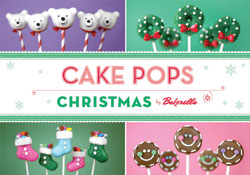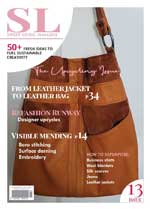 Bakerella, aka Angie Dudley, is cake pop queen, with her first book, Cake Pops, introducing the world to delicious candy-covered cakes on a stick. Since she posted her first cake pop designs on her website in 2008, these fancy treats have become an international phenomenon. Now she’s released her new book, Cake Pops Christmas, just in time for the festive season. And we’re lucky to feature an extract from the book, which is available from all good book shops.
Bakerella, aka Angie Dudley, is cake pop queen, with her first book, Cake Pops, introducing the world to delicious candy-covered cakes on a stick. Since she posted her first cake pop designs on her website in 2008, these fancy treats have become an international phenomenon. Now she’s released her new book, Cake Pops Christmas, just in time for the festive season. And we’re lucky to feature an extract from the book, which is available from all good book shops.
POLAR BEAR CAKE POPS
Keep these cute little bears cuddled with cozy red scarves.
YOU’LL NEED
48 uncoated cake balls (see recipe below)
48 oz (1.4 kg) white candy coating
Deep, microwave-safe plastic bowl
144 white M&M’s
48 lollipops sticks
Styrofoam block
48 black confetti sprinkles
Black edible-ink pen
8 oz (225 g) red candy coating
Small, microwave-safe plastic bowl
48 jumbo red heart sprinkles
Toothpicks
TO DECORATE
1. Have the cake balls chilled and in the refrigerator.
2. Melt the white candy coating in the deep microwave-safe bowl, following the instructions on the package. The coating should be about 3 in (7.5 cm) deep for easier dipping.
3. Remove the baking sheet of cake balls from the refrigerator. Dip 2 M&M’s in the melted coating and attach to a cake ball in position for the ears. Then attach 1 M&M to the front of the pop for the bear’s snout. Repeat until all the polar bear heads have ears and snout attached. Place in the freezer for a few minutes to firm up again, then transfer to the refrigerator to keep firm, not frozen.
4. When you are ready to dip, remove a few cake balls at a time from the refrigerator, keeping the rest chilled.
5. One at a time, dip about 1⁄2 in (12 mm) of the tip of a lollipop stick into the melted candy coating and insert the dipped end straight into the bottom of a polar bear head, pushing it no more than halfway through. Being very careful not to dislodge the ears or snout, dip the cake pop into the melted coating. Gently lift the pop out of the coating and tap off any excess. Stand the pop firmly in a hole in the Styrofoam block. Repeat with the remaining polar bear heads. Let dry completely.
6. When the pops are dry, use a toothpick to dot a small amount of the melted candy coating in position for the nose and attach a black confetti sprinkle. Draw on eyes and mouth with a black edible-ink pen and let dry.
7. Meanwhile, melt the red candy coating in the small microwave-safe bowl.
8. When the cake pops are dry, working with 1 bear at a time, gently twist and remove the lollipop stick. Holding the bear upright by the top of the head, re-dip the bottom in the melted red candy coating to form the scarf. Then re-dip about 1⁄2 in (12 mm) of the lollipop stick in the coating and insert it back into the bottom of the cake pop. Attach a jumbo heart sprinkle to the red coating to finish off the scarf with a ‘knot’. Return to the Styrofoam block. Repeat with the rest of your polar bears.
9. Let the cake pops dry completely.
Tips
• For a fun North Pole feel, use a sturdy red-striped paper straw instead of a lollipop stick.
• If you can’t find black confetti sprinkles, don’t worry. You can also use the black edible-ink pen and draw on top of any other colour confetti sprinkle.
BASIC CAKE POPS
Once you know how to make a basic cake pop, it’s easy to start making the projects in this book or create your own designs.
YOU’LL NEED
18.25-oz (520-g) box cake mix
9-by-13-in (23-by- 33-cm) cake pan
Two baking sheets
Wax paper
Large mixing bowl
16-oz (455-g) container ready-made frosting
Large metal spoon
Plastic wrap
48 oz (1.4 kg) candy coating
Deep, microwave-safe plastic bowl
48 lollipop sticks
Styrofoam block
MAKES 48 CAKE POPS
1 . Bake the cake as directed on the box, using the 9-by-13-in (23-by-33-cm) cake pan. Let cool completely.
2. Once the cake has cooled, get organised and set aside plenty of time (a couple of hours) to crumble, roll, and dip 4 dozen cake pops. Line the baking sheets with wax paper.
3. Crumble the cooled cake into the large bowl. You should not see any big pieces of cake.
4. Add up to three-quarters of the container of frosting to the bowl. (You will not need the remaining frosting. Save it in the refrigerator for a later use.) Mix it into the crumbled cake, using the back of a large metal spoon, until thoroughly combined. If you use the entire container, the cake balls will be too moist.
5. The mixture should be moist enough to roll into 1 1⁄2 -in (4-cm) balls and still hold a round shape. After rolling the cake balls by hand, place them on the prepared baking sheets and let them rest for about 20 minutes before chilling.
6. Cover with plastic wrap and chill for several hours in the refrigerator, or place them in the freezer for about 15 minutes. You want the balls to be firm but not frozen.
7. Place the candy coating in the deep microwave-safe bowl. These bowls make it easier to cover the cake balls completely with candy coating while holding the bowl and without burning your fingers. The coating should be about 3 in (7.5 cm) deep for easier dipping. I usually work with about 16 oz (455 g) of coating at a time.
8. Melt the candy coating, following the instructions on the package. Microwave on medium power for 30 seconds at a time, stirring with a spoon between each interval. You can also use a double boiler. Either way, make sure you do not overheat the coating.
9. Now you’re ready to dip. Take a few cake balls out of the refrigerator or freezer to work with, keeping the rest chilled. If they’re in the freezer, transfer the rest of the balls to the refrigerator at this point so they stay firm but do not freeze.
10. One at a time, dip about 1⁄2 in (12 mm) of the tip of a lollipop stick into the melted candy coating, and then insert the lollipop stick straight into a cake ball, pushing it no more than halfway through.
11 . Holding the lollipop stick with cake ball attached, dip the entire cake ball into the melted candy coating until it is completely covered, and remove it in one motion. Make sure the coating meets at the base of the lollipop stick. This helps secure the cake ball to the stick when the coating sets. The object is to completely cover the cake ball and remove it without submerging it in the coating more than once. A small, deep plastic bowl is very helpful during this step. If you do re-submerge the cake pop, the weight of the candy coating can pull on the cake ball and cause it to get stuck in the coating.
12. The thinner the consistency of your coating, the easier it will be to coat the cake pops. If you find that your coating is too thick, add some vegetable oil or paramount crystals to help thin it and make the coating more fluid.
13. When you remove the cake pop from the candy coating, some excess coating may start to drip. Hold the cake pop in one hand and use the other to gently tap the first wrist. Rotate the lollipop stick if necessary to allow the excess coating to fall off evenly, so one side doesn’t get heavier than the other. If you didn’t completely dunk the cake pop, this method of tapping and rotating generally takes care of that. The coating will slowly slide down the surface of the cake ball until it reaches the lollipop stick.
14. If too much coating surrounds the base of the lollipop stick, you can wipe the excess off with your finger. Simply place your finger on the stick right under the cake ball and rotate the pop, allowing any excess coating to fall off and back into the bowl of coating. When most of the excess coating has fallen off and it is no longer dripping, stick the cake pop into the Styrofoam block.
15. Repeat with the remaining cake balls and let the pops dry completely in the Styrofoam block.
16. Enjoy!
Tips
• Make the cake the day before, and let it cool overnight.
• Use a toothpick to encourage the coating to cover any small exposed areas or to make sure it surrounds the lollipop stick.
• Make sure the cake balls are chilled and firm when you dip them. If they are room temperature, they are likely to fall off the lollipop sticks into the melted candy coating. You can always return them to the freezer for a few minutes to quickly firm up again.
• Experiment with different colours of candy coating and sprinkles.
• You can also make cake pops into different shapes. Just roll them into balls, place in the freezer or refrigerator to firm and mould into your desired shape.
• Poke holes in the Styrofoam block before you start dipping. Just use one of the lollipop sticks to make holes about 2 in (5 cm) apart.

Extract from Cake Pops Christmas
by Bakerella/Angie Dudley
RRP $19.99 Hardback Spiral Bound
© Chronicle Books
Distributed by Bookreps.co.nz
 My Favourites
My Favourites










Speak Your Mind